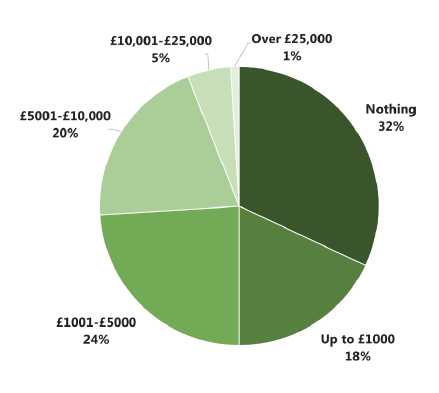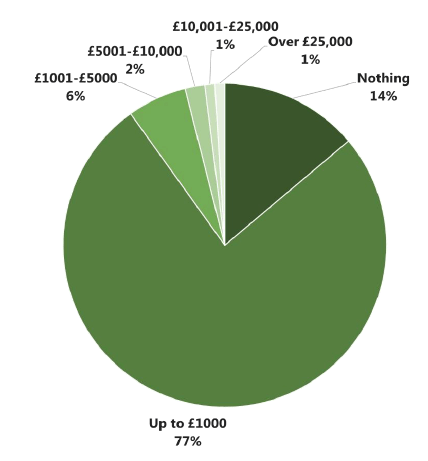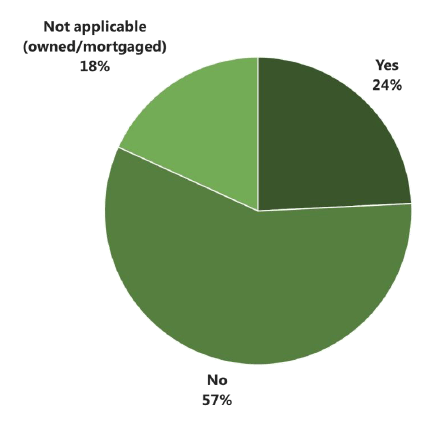Economic conditions of crofting 2015-18: survey
This report provides a detailed outline of the uses and financial situation of crofts in the years between 2015 and 2018.
5. Investments in the croft
5.1 Crofters were asked whether they had invested in their croft in the last three years. Just over two thirds of crofters (68%) stated that they had invested in their croft in this period while a third (32%) had not. This represents a considerable increase in the proportion of individuals investing, up from 58% in the 2011-2014 period. This is also higher than the proportion of crofters who said that they planned to invest in their croft in the 2015-2018 period in the previous survey (55%).
5.2 Of those that had invested in their croft since 2015, the median figure was £5,000, while the mean was much higher at £20,007. As Figure 5.1 illustrates, over half of those that had invested (48%) had invested up to £5,000 of their own money, with; around a fifth had invested £5,001-£10,000 (17%) and a further one in five had invested £10,001-£50,000 (20%).
Figure 5.1 Q Approximately how much in total was invested in your croft during the 2015-2018 period (Base: 412)

5.3 Fewer crofters had invested money from grant money/support schemes in the last three years with less than a quarter (24%) of those who had invested reporting such investment, and the median just £1,000 while the mean investment from these was £6,554.
5.4 While the proportion of those who had received public funding was consistent with that in 2014, the mean assistance per croft had increased from £4,900.
5.5 Less common still was investment through secured and unsecured loans with just 5% having made each of these types of investment. The mean investment through a secured loan was £3,664 (median was £0), while the mean investment from an unsecured loan was £4,115 (median £0).
5.6 In line with results for the 2011-2014 period, the majority of investments were related to agriculture with two thirds (66%) of crofters reporting that all their investment related to agriculture and a further one in ten (10%) saying that most of their investment related to agriculture, as shown in Figure 5.2. Less than one in ten (8%) crofters stated that none of their investment was related to agriculture.
Figure 5.2 Q To what extent was the investment in your croft during the 2015-2018 period related to agriculture? (Base: 433)

5.7 Around one in six (16%) of those who had invested in their croft in the last three years reported receiving additional income as a result of this investment. The median additional income was £1,500, while the mean figure was £6,219. The median reported additional income has fallen since 2011-2014, from £2,100, while the mean figure has increased from £4,400.
5.8 As can be seen in Figure 5.3, the majority of those who had received additional income had received up to £5,000 (83%), while 4% reported receiving £5,001-10,000, 11% received £10,001-£50,000 and 3% received £50,001-£100,000.
Figure 5.3 Q How much additional income have you received as a result of the investment made in your croft? (Base: 69)

5.9 More than eight in ten crofters (84%) said this was unlikely to change in the next twelve months, while 12% expected it to increase moderately and 4% to decrease moderately.
5.10 Livestock was the greatest contributor to additional income among crofters, as shown in Figure 5.4.[14] Almost two thirds of crofters attributed additional income to their livestock, while 17% had received additional income from a Bed and breakfast/holiday let, and 13% stated that crops had produced additional income.
Figure 5.4 Q Which of the following is the planned investment in your croft during the 2019-2022 period related to? (Base: 334)

5.11 Crofters were asked about their planned investment for the next three years. Just under half (48%) indicated that they did plan to invest in their croft within this time frame, down from 55% in 2014.
5.12 The median planned investment stated was £2,000, while the mean figure was much higher at £16,450, and up from £9,100 in 2014.
5.13 Livestock was by far the most common area of intended investment with almost six in ten (57%) crofters citing it as an area of planned investment, while crops were the next most common, at just under three in ten (28%) followed by bed and breakfast/holiday let at 16%.
5.14 Over half of crofters (52%) did not plan to invest in their croft in the next three years. Younger crofters tended to be more likely to invest than older crofters, with the highest proportion of 35-54 year olds planning to invest (70%) of all age groups, compared to just 30% of those aged over 65. Time spent crofting was also related to crofters’ likelihood to invest in the next three years with those who had been crofting 3-10 years the most likely to invest, at 72%.
5.15 Consistent with 2014, the three most common reasons for not investing were uncertainty of the potential benefit of investing (35%), that the financial cost/outlay of investing was too great (33%) and that there was no perceived desirable opportunity to do so (22%), as illustrated in Figure 5.5.
5.16 Reasons for not investing varied by gender and tenure. Male crofters were more likely than female crofters (37% compared to 21%) to cite uncertainty of the potential benefit of investing as a reason for not planning to invest; while Owner Occupier crofters were more likely than Tenant crofters to indicate that they felt there was no need to invest at present (11% compared to 5%).
5.17 Other reasons commonly given were a lack of funding sources to invest (20%); old age, ill health or retirement plans (14%) and a lack of information on how to invest (9%).
Figure 5.5 Q If you are not planning on investing in the period 2019-2022 what are the main reasons? (Base: 259)

5.18 Some crofters provided commentary on why they were not planning to invest in the future, which was in line with the findings above.
“Lack of investment due to no subsidies being received. No entitlements to be able to receive subsidy.”
“No idea where to get proper, instructive, or helpful advice.”
Contact
Email: Neil Davidson
There is a problem
Thanks for your feedback